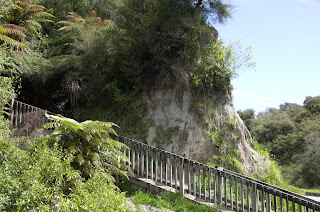 |
| Overview of Waimangu |
 |
| The southern crater |
 |
| The Emerald Pool |
 |
| The southern crater |
 |
| Another overview of Waimangu |
 |
| Frying Pan Lake |
The crystal wall is an area of warm ground that grows sulfur crystals. They will be destroyed by rain of which there is quite a bit here. So they must be growing at a pretty fast rate.
 |
| The Crystal Wall |
 |
| The streams runs continuously through the valley. It cools as it descends from the more active volcanic vents. |
 |
| The acidic water is conducive to algae growth providing a cacaphony of greens |
 |
| A few boardwalks keep us above the danger areas. |
 |
| Clam shell spring |
 |
| Water birds are common at the lower levels |
 |
| The stream enters Lake Rotomahana |
 |
| Canada Geese |
 |
| Black Swan |
 |
| We could take a boat ride on the lake at the end of the walk. |
 |
| Stoats are one of the introduced animals killing local birds. Traps and poisons are used to control and eliminate them. Others include rats, weasels, possums, and cats. |






















No comments:
Post a Comment